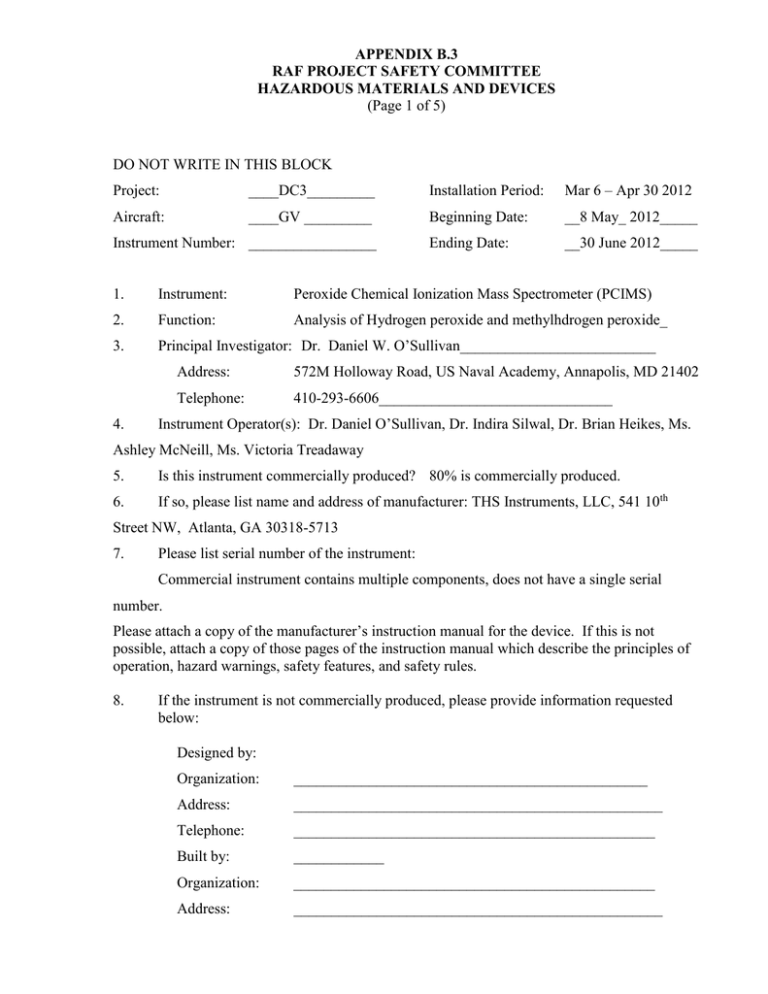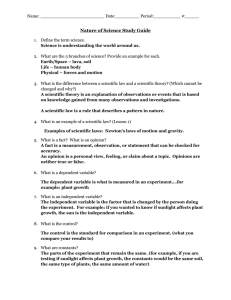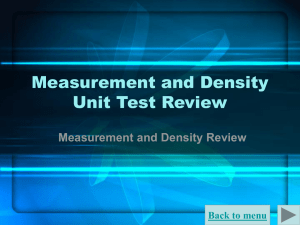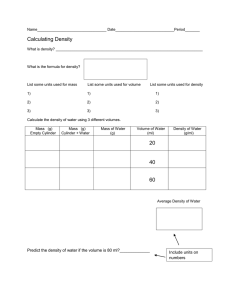APPENDIX B.3 RAF PROJECT SAFETY COMMITTEE HAZARDOUS MATERIALS AND DEVICES
advertisement

APPENDIX B.3 RAF PROJECT SAFETY COMMITTEE HAZARDOUS MATERIALS AND DEVICES (Page 1 of 5) DO NOT WRITE IN THIS BLOCK Project: ____DC3_________ Installation Period: Mar 6 – Apr 30 2012 Aircraft: ____GV _________ Beginning Date: __8 May_ 2012_____ Ending Date: __30 June 2012_____ Instrument Number: _________________ 1. Instrument: Peroxide Chemical Ionization Mass Spectrometer (PCIMS) 2. Function: Analysis of Hydrogen peroxide and methylhdrogen peroxide_ 3. Principal Investigator: Dr. Daniel W. O’Sullivan__________________________ 4. Address: 572M Holloway Road, US Naval Academy, Annapolis, MD 21402 Telephone: 410-293-6606_______________________________ Instrument Operator(s): Dr. Daniel O’Sullivan, Dr. Indira Silwal, Dr. Brian Heikes, Ms. Ashley McNeill, Ms. Victoria Treadaway 5. Is this instrument commercially produced? 80% is commercially produced. 6. If so, please list name and address of manufacturer: THS Instruments, LLC, 541 10th Street NW, Atlanta, GA 30318-5713 7. Please list serial number of the instrument: Commercial instrument contains multiple components, does not have a single serial number. Please attach a copy of the manufacturer’s instruction manual for the device. If this is not possible, attach a copy of those pages of the instruction manual which describe the principles of operation, hazard warnings, safety features, and safety rules. 8. If the instrument is not commercially produced, please provide information requested below: Designed by: Organization: _______________________________________________ Address: _________________________________________________ Telephone: ________________________________________________ Built by: ____________ Organization: ________________________________________________ Address: _________________________________________________ APPENDIX B.3 RAF PROJECT SAFETY COMMITTEE HAZARDOUS MATERIALS AND DEVICES (Page 2 of 5) 9. Describe principles of operation, hazard warnings, safety features: A completely contained Po210 alpha source is used to ionize reagent molecules which form adduct ions with the peroxides at unique masses. The number of adduct ions is determined and is proportional to the ambient concentration of the peroxide. 10. If the instrument is commercially produced, has it been modified? Yes 11. If modified, describe the modification. Several of the commercial component interconnecting wires and connectors have been replaced with HIAPER certified materials. All investigators please answer the following: 12. 13. Does the instrument contain, use, or produce: Radioactive materials ___X___ Compressed gases ___X___ Other ionizing radiation ______ Non-ionizing radiation ___X ___ Flammable liquids ______ Laser ______ Radar ______ Flammable gases ______ Explosive materials ______ Toxic materials ______ If any of the categories were checked, specify the material below (for example, amount, energy levels, physical form, etc.). Radioactive material: Nucleocell static eliminator, completely contained 20 mCi Po-210 alpha source, from NRD LLC. Compressed gases: A small 2L compressed gas cylinder (ALT789 cylinder from Aviation oxygen systems, Inc, nitrogen at 1500 psi) contained within the rack, and an aluminum cylinder of ultrapure nitrogen (size 150A, Scott-Marrin Inc, 2000 psi) in the aft bottle rack. Non-ionizing radiation: A UV light source lamp completely contained within the rack (UVP LLC, Ozone generator). APPENDIX B.3 RAF PROJECT SAFETY COMMITTEE HAZARDOUS MATERIALS AND DEVICES (Page 3 of 5) 14. Please list all other chemicals you will use on board this aircraft in your experiment. Urea hydrogen peroxide, <0.5 gram, completely contained. Dilute solution of hydrogen peroxide and methylhydroperoxide 0.005 M each with a total volume of 1.5 mL. 15. If your experiment consumes or discharges materials, will you need to carry additional materials on board? No. 16. What and how much extra materials will you need to carry? None. 17. What kind of container will you need to carry these materials? N/A_______________________________________________________________ 18. If the device utilizes a laser, please classify the laser according to ANSI Z 136.1-1973 (circle one). Class: I II III IV 19. If your laser will be operating at a wavelength that is not eye safe, what procedures will be established to minimize the danger to yourself and other project participants? N/A 20. If you are using compressed gas cylinders, what is the maximum pressure expected for each cylinder type? Ultrapure nitrogen cylinder size 150A, 2000 psi (Scott-Marrin, Inc.) Zero air with methyliodide (7.5 psi in 1500 psi zero air or ultrapure N2, self-filled) 21. Will you be re-filling any compressed gas cylinders yourself, either at JeffCO or during the field deployment? Yes, we will need to refill the 2L reagent ion source gas cylinder (ALT789 cylinder from Aviation Oxygen Systems, Inc, nominally trace methyliodide in compressed nitrogen, filled to a total pressure of 1500 psi). The cylinder is rated to 6000 psi. APPENDIX B RAF PROJECT SAFETY COMMITTEE HAZARDOUS MATERIALS AND DEVICES (Page 4 of 5) 22. Are there any other hazards associated with the instrument itself, the required ground support equipment or the experiment which have not so far been covered in this questionnaire? We will deploy a ground based peroxide calibration system. The system involves a number of aqueous chemical solutions. All are dilute aqueous solutions that can be disposed of down the drain and do not represent a significant hazard. Cleaning solution of 1 N HCl and 1 N NaOH in small volumes will be used. A small volume of concentrated ammonium hydroxide will be used in the ground based system. We will provide appropriate spill clean-up kits for the ground. These solutions will not be used on the aircraft. Neat methyliodide will be used to fill the reagent ion source cylinder. The following chemical, concentration, phase, and quantity x size-container are used in preparation of the ground based calibration instruments reagents, these are used on the ground and require proper chemical storage and handling at RAF and in the field. a. Ammonium Hydroxide 30% aqueous solution, liquid, 2 x 0.5 Liter b. Sulfuric Acid 98%, liquid, 20 x 0.001 Liter ampules c. Hydrochloric Acid 1 normal, liquid, 2 x 0.5 Liter d. Sodium Hydroxide, 1 normal, liquid, 2 x 0.5 Liter e. Sodium Hydroxide, solid, 5 x 40 grams f. Potassium hydrogen phthalate, solid, 40 x 40 grams g. methanol, liquid, 1 x 0.5 liter, h. horseradish peroxidase enzyme, solid, 5x 200 KU (enzyme units, ~ 10 grams) i. 4-hydroxyphenylacetic acid, solid, 40 x 2 grams j. Orion pH buffer solutions (4.0, 7.0, 10.0), liquid, 75 x 0.025 liter. k. water, pure, liquid, 15 x 20 Liter l. Acridinium ester 1 mM solution, liquid, 2 x 0.5 Liter m. Sodium borate, solid, 15 x 20 grams n. Sodium hydrogen phosphate monobasic, solid, 5 x 13 grams Note: All of these chemicals can be stored in a refrigerator with a freezer designated for chemical storage only and/or in a dry chemical storage locker. 23. How would you describe the probability of an accident resulting from the presence and use of your instrument on board the NCAR aircraft? Very low. APPENDIX B RAF PROJECT SAFETY COMMITTEE HAZARDOUS MATERIALS AND DEVICES (Page 5 of 5) 24. How would you describe the severity of such an accident? 25. What precautions will you take to decrease the probability and the severity of an accident? If any documented safety procedures from your home facility or university are available, please attach a copy of said materials to this form. 10 FEB 12 ________________________________________________ Date Signature of principal investigator or operator _Daniel W. O’Sullivan________________________ Printed name of principal investigator or operator ________________________________________________ Reviewed by ________________________________________________ Date




